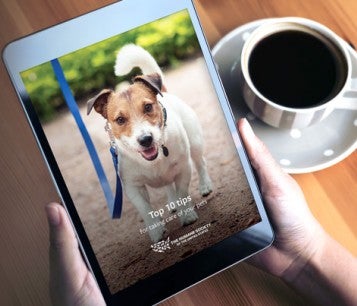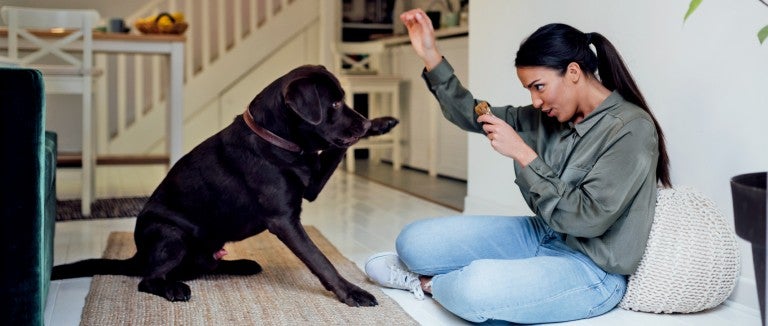Dogs respond best to praise—and food or toys. Positive reinforcement training uses a reward for desired behaviors. Because the reward makes them more likely to repeat the behavior, positive reinforcement is one of your most powerful tools for shaping or changing your dog’s behavior.
Rewarding your dog for good behavior sounds pretty simple and it is! But to practice the technique effectively, you need to follow some basic guidelines.
Sign up to receive our exclusive e-book full of important information about caring for your pet, including training techniques and answers to frequently asked questions.

Timing is everything
Correct timing is essential when using positive reinforcement training. The reward must occur immediately (within seconds) of the desired behavior, or your pet may not associate it with the proper action. For example, if you have your dog sit but reward them after they’ve stood back up, they’ll think they’re being rewarded for standing.
Keep it short
Dogs don’t understand sentences. Dogs learn from our body language, so first work on encouraging your dog into a “sit” or “down” before asking them with a word. Holding a toy or treat, slowly move your hand over and slightly behind your dog’s head so that they have to sit to look up and view it. When your dog is sitting, you can lure them into a down position by slowly lowering your hand and bringing the reward close to the ground between their front paws.
Once your dog is performing the behavior consistently, start adding the word “sit” or “down” in a calm voice and try not to repeat the word. Keep verbal cues short and uncomplicated.
The most commonly used verbal cues are:
- watch (eyes on me)
- sit
- stay
- down (lie down)
- off (get off me, someone else, the furniture)
- up (stand up)
- come (to me)
- heel (walk close to my side)
- leave it (don’t touch or pick up something from the ground)
- drop or give (when trading something in their mouth for a treat or toy)
Consistency is key
Everyone in the family should use the same cues, otherwise your dog may get confused. It might help to post a list of cues where everyone can become familiar with them. Consistency with positive reinforcement training also means always rewarding the desired behavior and never rewarding undesired behavior.
When to use positive reinforcement
THE GOOD
Positive reinforcement training is great for teaching your dog cues and it's also a good way of reinforcing good behavior. You may have your dog sit:
- before letting them outside (which helps prevent door-darting)
- before petting them (which helps prevent jumping on people)
- before feeding them (which helps teach good mealtime manners)
Give them a pat or a "good dog" for lying quietly by your feet or slip a treat into a Kong-type toy when they chew that instead of your shoe.
THE BAD
Be careful that you don't accidentally use positive reinforcement training to reward unwanted behaviors. For example, if you let your dog outside every time they bark at a noise in the neighborhood, you're giving a reward (access to the yard) for behavior you want to discourage.
Shaping behavior
It can take time for your dog to learn certain behaviors. You may need to use a technique called "shaping," which means reinforcing something close to the desired response and then gradually requiring more from your dog before they get a treat.
For example, if you're teaching your dog to "shake," you may initially reward them for lifting a paw off the ground, then for lifting it higher, then for touching your hand, then for letting you hold their paw and finally, for actually "shaking hands" with you.
Types of rewards
Positive reinforcement training can include food treats, praise, petting, or a favorite toy or game. Since most dogs are highly food-motivated, food treats work especially well for training.
- A treat should be enticing and irresistible to your pet. Experiment a bit to see which treats work best.
- It should be a very small (pea-sized or even smaller for little dogs), soft piece of food, so that they will eat it quickly and look to you for more. Don’t give your dog something they have to chew or that breaks into bits and falls on the floor.
- Keep a variety of treats handy so your dog won't become bored getting the same treat every time.
- Each time you use a food reward, you should couple it with a verbal reward (praise). Say something like "yes" or "good dog" in an enthusiastic tone of voice. Then give your dog a treat.
If your dog isn't as motivated by food treats, a toy, petting or brief play can also be very effective rewards.
When to give treats
When your pet is learning a new behavior, reward them every time they demonstrate that behavior. This is called continuous reinforcement. Once your pet has reliably learned the behavior, you want to switch to intermittent reinforcement.
- At first, reward with a treat four out of every five times they do the behavior. Over time, reward three out of five times, and so on, until you’re only rewarding occasionally. Don’t decrease the rewards too quickly or your dog could become frustrated or confused.
- Continue to praise every time—although once your dog has learned the behavior, your praise can become less excited.
- Vary how often you provide the reward so that your dog doesn’t figure out that they only have to respond every other time, for example. Your pet will soon learn that if they keep responding, eventually they’ll get what they want—your praise and an occasional treat.
By understanding positive reinforcement training, you'll see that you're not forever bound to carry a pocketful of goodies. Your dog will soon be working for your verbal praise, because they want to please you and know that, occasionally, they'll get a treat too.
Will using treats encourage a dog to constantly beg for food?
Context is everything. If you’re feeding your dog from the dinner table, they’ll likely stick around for handouts, but if you’re using treats during training sessions, your dog will know they’re working for a reward.
How to find a dog trainer who uses positive reinforcement
While there’s currently no national credentialing for dog trainers, a few entities only certify trainers who use positive reinforcement training methods. Visit the Association of Professional Dog Trainers to search for a trainer in your area or ask a local trainer what methods and techniques they use to be sure you’re comfortable with the approach.
